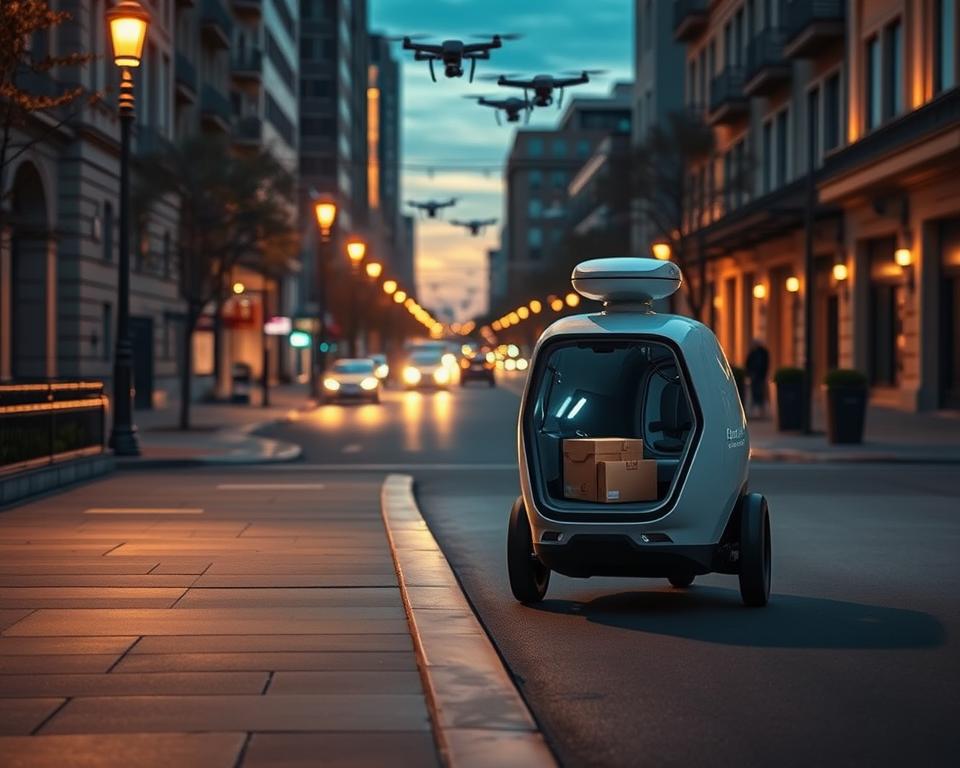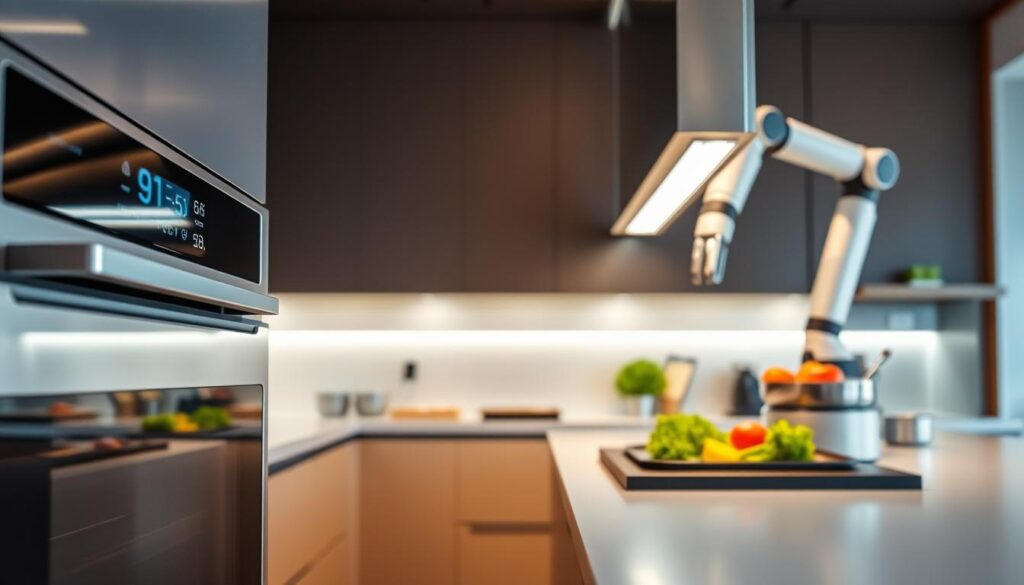Anúncios
Can robots really make your orders faster, safer, and cheaper? The rise of food delivery technology has moved robotics from novelty to a core option for restaurants and businesses.
You’ll learn why this matters now. Apps and AI-driven logistics give customers real-time tracking and accurate ETAs. That expands market reach and boosts operational efficiency for many businesses.
Real examples such as Meituan’s drone routes and Flytrex’s limited U.S. zones show how autonomous systems work in the real world.
This short guide previews trade-offs you’ll face when adding robots to service workflows: costs, staffing changes, regulatory hurdles, and data security. It also points to where robots win and where traditional options stay smarter for your business.
Read on to map opportunities in your local market and decide which paths fit your goals.
Anúncios
Introduction: Why food delivery technology is reshaping how you eat and restaurants operate
Ordering moved from a call to a tap, and that change rewired the entire market. Consumers now expect fast service, clear tracking, and accurate ETAs every time they place an online order.
Apps and conversational AI made browsing menus, paying, and status updates normal. Businesses gained efficiency by using data to optimize routes, batch orders, and cut wait times. Ghost and cloud kitchens grew during lockdowns, offering lower staffing needs and flexible locations that pair well with robotics.
Contactless proof-of-delivery options — barcode scans, delivery photos, geolocation, and optional face recognition — are already practical. Meituan’s drone-to-kiosk routes and Flytrex’s U.S. pilots show how aerial systems fit rules and real-world limits.
Anúncios
This short report previews investment, smart kitchens, last-mile robots, drones, autonomous vans, conversational AI, and regulation. You’ll get simple metrics and a framework to test new tools, measure growth and efficiency, and keep the customer experience strong across services.
From pizza nights to robot-powered logistics: the new baseline for convenience
- How ordering evolved to app-first habits and what consumers expect now.
- Why precise routing and tight delivery windows matter for hot meals.
- Practical steps you can use to pilot robotics and track ROI.
The market moment: Investment, competition, and what’s at stake
A funding surge changed the stakes: startups raced to scale while unit economics lagged. Estimates show about $3.2B flowed into restaurant-focused platforms, rivaling a decade of IPO proceeds for chains. These figures reflect available research context and help explain why players moved fast.
Billions meet fierce competition and consolidation
The space saw big winners and fast exits. Maple, SpoonRocket, and Sprig raised a combined $108M before shutting down. At least 15 M&A deals among startups had closed by 2017.
What that means for you: funding can buy growth, but it does not guarantee sustainable margins. Companies that scaled without strong unit economics often folded or were acquired.
Off-premise demand and the gap robotics targets
- Huge opportunity: around $210B of restaurant food is eaten off-premise, while the market for delivery sat near $30B — clear room to grow.
- Why robotics matters: emerging technologies aim to lower last-mile costs, raise utilization, and keep service steady at peak times.
- Actionable signals: track order density, batching rates, and on-time percentages to prove gains and reduce cost per drop.
In short, you compete in a landscape fueled by capital and consolidation. Use these market signals to shape your platform and partnerships. Invest where automation improves reliability and customer outcomes, not just headlines.
Inside the kitchen: Automation, smart stations, and the rise of ghost kitchens
Ghost kitchens are built for speed, turning order spikes into predictable workflows. These delivery-first hubs cut front-of-house needs so you can focus labor and space on production. Lower rent and locations near transport arteries helped them scale during lockdowns.
Ghost/cloud kitchens as robotics-ready hubs for speed and scale
Separate dining from production and you shorten handoff times to couriers and bots. Smart stations and kitchen screens align prep with ETA targets so hot items stay hot and cold items stay cold. Automated labeling and handoff lockers reduce mistakes and speed pickups.
AI-driven prep, inventory, and workflow orchestration
AI links orders to stock and staff in real time. When ingredients run out, menus update in the app and customers see accurate choices. Predictive prep helps you staff peaks without overspending during slow hours.
- Use predictive slotting to reduce rework and lower wait times.
- Test conveyors, cubbies, and pickup lockers to shorten dwell time.
- Centralized procurement supports multi-brand facilities and improves margins.
For a practical playbook on tying orders, inventory, and labor together, see the guide on integrating AI in ghost kitchen operations. Data loops reveal which meals travel best and where to tweak recipes or packaging to protect quality after dispatch.
Last mile gets smarter: Sidewalk robots, drones, and autonomous vehicles
Smart last-mile options let you pair the right vehicle with each order and location. That choice affects routing, cost, and how well meals arrive on time. Use cases differ by distance, curb access, and customer expectations.

Sidewalk bots for campuses and dense neighborhoods
Sidewalk robots shine where short walks and low speeds keep trips predictable. On campuses and dense blocks, these bots reduce labor cost and keep your service local and steady.
Drones for short hops and pickup kiosks
Fixed routes simplify air navigation. Meituan’s kiosk model uses repeatable drone legs to cut complexity in crowded urban airspace. Flytrex pilots in the U.S. show how limited geographies validate demand while meeting safety rules.
Autonomous vans for batching and temperature control
Autonomous vans let you move many orders at once and keep hot and cold items separate. This improves time-to-door and reduces wasted trips for companies that need scale.
- Dynamic routing prioritizes orders by prep-ready time and distance to hit tight windows.
- Clear handoffs—lockers, QR codes, and photos—lower failed drops and build trust with customers.
- Blending bots, drones, and drivers lets you assign the right mode by curb access and service promise.
food delivery technology meets conversational AI: Seamless ordering and tracking
Conversational interfaces are turning complex menus and status screens into a single, friendly chat. You can browse options, get recommendations, pay, and follow an order without jumping between screens. That reduces friction and speeds the path from browse to checkout.
Chat-based menus, recommendations, and status updates
Ask in plain language and the platform will surface portions, add-ons, and suggested combos so you don’t scroll long lists. Personalization uses consensual data to make relevant suggestions and send timely rewards.
Real-time tracking, dynamic ETAs, and exception handling
- Dynamic ETAs reflect prep and traffic so you know when the order arrives.
- The same chat handles exceptions—gate codes, address edits, or safe-place notes—which cuts failed attempts.
- Integrated payments and secure tokens remove checkout friction while protecting sensitive info.
- Staff chatbots support drivers and kitchen teams with schedules and troubleshooting around the clock.
- Measure conversion, average ticket, and reorder rates from chat flows to prove efficiency gains.
Clear opt-ins and privacy controls keep customers in charge of their data, building trust while letting your business deliver better experiences.
Safety, privacy, and regulation: Building trust in robotic deliveries
Trust hinges on clear rules, smart safeguards, and predictable handoffs when robots carry orders. You need a plan that covers permits, verification, and how you protect people’s information.
Navigating FAA, city permits, and sidewalk-right-of-way rules
Map each mode to the right regulator. Drones must meet FAA rules and often avoid direct-to-door flights by routing to kiosks. Sidewalk robots need city permits and curb-access agreements.
Tip: Coordinate early with local agencies on curb space, flight corridors, and right-of-way to prevent delays.
Data security, customer verification, and contactless proof-of-delivery
Use contactless proof-of-delivery to speed handoffs and respect privacy. Options include barcode scans, geo-location pings, and photos at drop-off. Offer optional, consent-based verification so customers choose what’s comfortable.
- Encrypt payments and limit stored personal data with defined retention windows.
- Train staff on exception handling and safe handoffs to keep service consistent.
- Keep an audit trail of process steps and completed drops to resolve disputes fast.
Clear policies in plain language—what you collect, why, and how long you keep it—build confidence with customers, restaurants, and regulators as you scale robotic services.
Economics and operations: Where robots cut costs—and where they don’t
Begin with a tight zone where orders cluster so you can measure real savings. Small pilots reveal whether automation lowers your per-drop cost or just shifts expense into maintenance and connectivity.
Route optimization, batching, and utilization math
Start with density: robots shine when multiple orders sit close together. Batching lifts utilization and trims cost per stop.
Use AI to stage orders by prep-ready time so bots arrive just in time. That protects quality and raises on-time rates.
Capex, maintenance, and staffing for hybrid fleets
Model total cost of ownership against courier costs before you scale a new platform. Include capex, upkeep, connectivity, storage, and ops staff in your spreadsheet.
Plan flexible staffing: human drivers handle complex or low-density routes while robots serve standard, repeatable runs.
- Track the right metrics: on-time rate, cost per order, average batch size, idle time, and first-attempt success.
- Expect diminishing returns in sparse neighborhoods or rough terrain—traditional drivers may win there.
- Build service tiers so premium windows offset higher costs while standard slots favor batching.
Keep a rolling ROI log. Growth, weather, and new hours shift the math. Measure often and adjust rules accordingly.
Real-world rollouts: What leading companies are piloting now
Leading pilots now show practical routes to scale while keeping customer expectations realistic. Meituan’s drone-to-kiosk flights and Flytrex’s limited U.S. zones are shaping sensible playbooks rather than full-city promises.
Drones to pickup kiosks and expanding suburban testbeds
Drone kiosk models avoid door-to-door flights by using fixed legs that simplify FAA compliance and improve repeatability.
Suburban testbeds help you learn whether roads, curb access, and order density suit autonomous carts or low-speed bots. Run short runs on clear routes to spot gaps before scaling.
Restaurant playbooks: Partnering, piloting, and measuring ROI
Partner with restaurants and platforms to share order data, align SLAs, and set clear definitions for “on-time” by order type.
- Pilot goals: set targets for on-time rate, cost per order, and customer satisfaction, and A/B test against driver-only controls.
- Pilot conversational AI alongside robotics so customers can chat for updates, edit drop-offs, and resolve issues without leaving the app.
- Train teams and run a short checklist for new handoffs before launch; start with one neighborhood or campus and expand based on results.
Document lessons learned. Track metrics and customer feedback so each rollout improves speed, consistency, and ROI across your local landscape.
Conclusion
Finish with a practical plan: pilot, measure, and iterate until the gains are clear. Start small and test how a mix of robots, drivers, and drones affects your delivery zones and meal quality.
Focus on the basics: use dynamic ETAs, real‑time tracking, and contactless verification like barcode scans or geo‑pings so customers get reliable updates. Align menus, packaging, and ingredients to travel well and reduce refunds.
Make the platform part of a simple process: blend chat-based apps for orders and exceptions, track on‑time rates and failed attempts, and let data show where automation improves efficiency. Start a short pilot this quarter, measure results, and expand the approaches that truly lift your customer experience in the evolving food delivery landscape.



